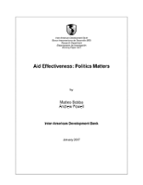Aid Effectiveness: Politics Matters
Date
Jan 2007
The literature on aid effectiveness has focused more on recipient policies than the determinants of aid allocation yet a consistent result is that political allies obtain more aid from donors than non-allies. This paper shows that aid allocated to political allies is ineffective for growth, whereas aid extended to countries that are not allies is highly effective. The result appears to be robust across different specifications and estimation techniques. In particular, new methods are employed to control for endogeneity. The paper suggests that aid allocation should be scrutinized carefully to make aid as effective as possible.



